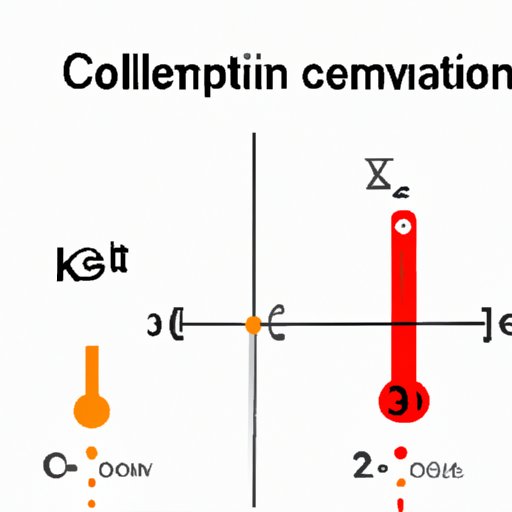
I. Introduction
Temperature conversions are an essential aspect of scientific and engineering calculations. Celsius and Kelvin are two of the most commonly used temperature scales, with Kelvin being the standard unit of temperature measurement in most scientific applications. In this article, we will explore in-depth how to convert Celsius to Kelvin, including an overview of the two temperature scales, the formula for conversion, tips and tricks, practical applications, and much more.
II. The Basics
Celsius and Kelvin are two temperature scales used to measure temperature. Celsius is a metric scale based on the freezing and boiling points of water. The freezing point is at 0 degrees Celsius, and the boiling point is at 100 degrees Celsius when measured at standard atmospheric pressure. Kelvin, on the other hand, is an international system of units (SI) for measuring temperature. It’s also called the absolute temperature scale, meaning it starts at absolute zero, which is the lowest temperature possible, where all molecular activity stops. The Kelvin scale has no negative values, and its zero is -273.15 degrees Celsius.
III. The Formula
To convert Celsius to Kelvin, you’ll use this simple formula:
K = C + 273.15
Where K is the temperature in Kelvin and C is the temperature in Celsius. To better understand the conversion process, let’s try solving some example problems.
Example 1: You’re given a temperature of 25 degrees Celsius. What is it in Kelvin?
To find the temperature in Kelvin, simply add 273.15 to the Celsius temperature:
K = C + 273.15
K = 25 + 273.15
K = 298.15K
Therefore, 25 degrees Celsius is equal to 298.15 Kelvin.
Example 2: You’re given a temperature of -10 degrees Celsius. What is it in Kelvin?
Since the Kelvin scale has no negative values, you first need to add 273.15 to the Celsius temperature to get the temperature in Kelvin:
K = C + 273.15
K = -10 + 273.15
K = 263.15K
Therefore, -10 degrees Celsius is equal to 263.15 Kelvin.
IV. Tips and Tricks
Converting Celsius to Kelvin may seem simple, but there are some common mistakes to avoid to make the process smoother. Here are some tips and tricks to help make conversion easier:
- Always double-check that you’re using the right formula, K = C + 273.15.
- Remember that Kelvin starts at absolute zero, so it’s not possible to have negative Kelvin temperatures.
- When converting large temperature values, use scientific notation for easier calculations.
You can also use some helpful shortcuts and mnemonic devices to make the conversion process easier. For example:
- Adding 273: To convert a temperature from Celsius to Kelvin, just add 273 to the Celsius measurement.
- “Celsius Carryover method”: Add 100 to the Celsius temperature, then subtract 32. Then, add 273. Keep this method in mind when mentally converting Celsius to Kelvin.
V. Understanding the Conversion
The Celsius to Kelvin conversion isn’t just a mathematical formula but plays a vital role in various scientific and engineering applications. As mentioned earlier, Kelvin is the standard unit of temperature measurement in most scientific and engineering applications. The conversion from Celsius to Kelvin is essential when working with gases, conducting experiments in cryogenics, and other low-temperature applications. Additionally, Kelvin is used in physics calculations, including thermodynamics, and frequently found in the scientific literature and research papers.
VI. Practical Application
Understanding how to convert Celsius to Kelvin is critical, especially in real-life settings. Here are some examples of where you might encounter the Celsius and Kelvin temperature scales:
- Weather: In meteorological reports, temperatures are usually reported in Celsius, so it’s essential to convert to Kelvin when conducting studies on atmospheric conditions.
- Cooking and Baking: Most recipes use Fahrenheit or Celsius, but some baking recipes require specific temperature settings that are given in Kelvin, so knowing how to make the conversion between Celsius and Kelvin can be beneficial.
- Medical and research journals: Many medical and research journals report temperature data in Kelvin, so you need to know how to convert from Celsius to Kelvin when reading and conducting research.
Additionally, Celsius to Kelvin conversion is a crucial aspect of calculations and problem-solving in scientific and engineering fields.
VII. Conclusion
Converting Celsius to Kelvin is a fundamental concept used in various scientific and engineering calculations and applications. In this article, we’ve explored the basics of the two temperature scales and provided step-by-step instructions on how to convert Celsius to Kelvin. We’ve also discussed some practical applications of the conversion and tips and tricks to make the process simpler. Remember to always double-check your calculation and use scientific notation for larger values. Furthermore, understanding the Celsius to Kelvin conversion helps you interpret and analyze scientific and technical information from research papers, journals, and other sources.
VIII. Bonus Content
To convert Kelvin to Celsius in reverse, use the following formula:
C = K – 273.15
Where C is the temperature in Celsius, and K is the temperature in Kelvin. Subtracting 273.15 from the Kelvin temperature will give you the equivalent temperature in Celsius.




